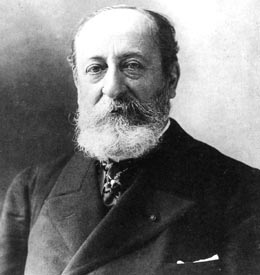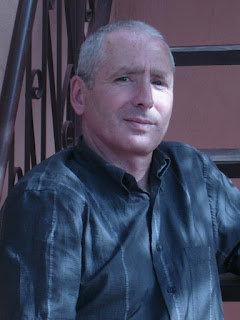Composer: Camille Saint-Saëns
- Javotte: I. Bourree
- Javotte: II. Scene et valse lente
- Javotte: III. Pas de deux
- Javotte: IV. Allegretto - Allegro non troppo presto
- Caprice sur les airs de ballet d'Alceste de Gluck
- Ascanio: Scene du mendiant
- Ascanio: Danse de l'amour
- Valse du "Le prophète" (after Meyerbeer)
- Henry VIII
- Paraphrase sur Mandolinata (after Paladihe)
- Proserpine, R 292: Prelude to Act II (arr. P. Bellenot)
- Proserpine, R 292: Pavane (arr. P. Bellenot)
- La Mort de Thais (after Massenet)
- Scherzo sur "Les Pecheurs de Perles" (after Bizet)
- Suite algérienne, Op. 60: IV. Marche militaire française
- Suite algérienne, Op. 60: III. Rêverie du soir
- Lola, Op. 116: Tango
- Élégie, Op. 160
- Rhasodie d'Auvergne, Op. 73
- Bénédiction nuptiale, Op. 9
- Une nuite a Lisbonne, op. 63 "Barcarolle"
- Souvenir d'Italie, Op. 80
- Paraphrase sur Las Islena (after Paladilhe)
- Fantasie sur l'hymne national russe (after A. Lwoff)
- Africa, Op. 89
Antony Gray, piano
Date: 2022
Label: Divine Art
----------------------------------------------------------------------------
With the exception of a couple of his Etudes the piano music of Camille Saint-Saëns has not really caught pianists' or the public's attention. Admittedly a lot of it is salon music but one only has to hear someone like Bertrand Chamayou essay a selection of his piano works, amongst them the famous étude en forme de valse from his op.52 set (Warner Classics 90295634261) to realise that with care they can be wonderfully effective. Geoffrey Burleson has recorded the complete piano music for Grand Piano (GP601, GP605, GP609, GP625 and GP626) and very good it is but it should be pointed out that although he has had access to and recorded arrangements and transcriptions that remain unpublished and in manuscript there are still many more pieces beyond that. Step up Mr Gray who has filled in many gaps with 4 CDs of solos, arrangements, transcriptions and paraphrases (Vol.2 also 2 CDs is on Divine Art DDA21236). Still not the complete Saint-Saëns though - there remain transcriptions of Beethoven, Mendelssohn, Haydn, Durand, Gounod and Duvernoy - but nonetheless this is a big step in the right direction.
Volume one is described as Opera, ballet and Places with disc one devoted to stageworks and disc two as the travel guide. Two ballets and two operas by Saint-Saëns are represented; hope once entertained that his ballet Javotte would follow the success of Coppelia and Giselle were optimistic but perhaps the publication of these four short numbers, bourrée, scène et valse lente, pas de deux and allegretto, quite obviously written for the amateur market was to further that hope. Likewise the excerpts from Ascanio though this grand opera based on the novel Benvenuto Cellini was certainly not a success; George Bernard Shaw's criticism was harsh, not an original phrase from beginning to end. The first piece was lifted pretty much intact from the vocal score and though this meditative Scène du mendiant might sit well for the amateur the arabesques of the delightful Danse de l'amour, a flute solo in the opera, would provide more of a challenge, younger cousin as it is to Liszt's la Campanella. The two pieces were written for the pianist Ignacy Jan Paderewski. Saint-Saëns' sixth opera Prosperine fared little better than Ascanio but the gentle opening prélude and mock-baroque pavan with its delicate false relations are pleasant enough miniatures. Far grander and substantial fare comes in the shape of the quartet from Henry VIII, which is more in the style of a Liszt transcription, grand and full of virtuoso flourishes that despite being a quartet actually concentrates on Henry's melody Anne ma bien aimée. Liszt is also to the fore when we look at the paraphrases of other composer's music. The Valse from Meyerbeer's opera La Prophète may not have the infernal quality that attracted to Liszt to another Meyerbeer offering Robert le diable but Saint-Saëns makes a very effective paraphrase from it incorporating a march from elsewhere in the opera. The outer waltz is basically a padded out version of the writing in the vocal score but the melancholy aria at the heart of the piece is given more dramatic weight. One wonders if the transcription of the final scene of Thaïs would be more popular if it incorporated all of the famous meditation from earlier in the score rather than the trimmed version that is in this scene but there is no denying the dramatic and visceral impact of this transcription. One of his most extended settings is the Caprice d'Alceste a work that was popular with Brazilian pianist Guiomar Novaes and was recorded by her and Harold Bauer but it seems to have been common practice to end before the fugue and while that makes for an attractive short set of variations Gray plays it in all its glory with the huge fugue, or more accurately fugal-fantasy that doubles its length.
Two songs by Emile Paladilhe appear in transcription; both Mandolinata and La Islena were hits for the composer and indeed he incorporated the former, written when he was in Rome after his Prix de Rome win, into one of his operas hence its inclusion here. It is a sparkling transcription, part strummed serenade and part spinning song while its companion, also known as Havanaise and dedicated to the Valkyrie of the Piano, Venezuelan pianist Teresa Carreño, receives a bravura treatment reminiscent of the style of Louis Moreau Gottschalk. More fireworks close the disc with the stunning Pearl Fishers Scherzo a work that remains unpublished but would be a welcome concert item especially with the famous duet ringing out at its heart.
The travel section of the collection opens in martial style with the marche militaire française from the Suite Algerienne, a suite that was quite popular once upon a time. This is one of the works that Saint-Saëns committed to disc in 1919 along with the Rêverie à Blidah, a nocturnal depiction of that Algerian city – these remarkable recordings can be found on Marston Records 52054-2 review and it is from this recording that this otherwise un-notated transcription is taken. This is a very western view of the African continent, more a tourist postcard than an attempt to authentically recreate the music of the country. The tango from the scène dramatique Lola was described by Saint-Saëns as exaggerated in its Spanishness which may have been true at the time. In our more cosmopolitan times it is a gentle dance that stands partway between the Albéniz Tango and Carmen's famous habanera but mostly lacks the memorability of either. The memory of composer Alexis de Castillon who had died young in 1873 was the inspiration for the beautiful Elégie originally for violin and piano, reflective rather than mournful; rather than just re-arrange it Saint-Saëns rewrote it in terms of the piano. Two larger works, the Rhapsodie d'Auvergne and Africa have become quite familiar in their versions for piano and orchestra but the solo versions are heard less often; they are nonetheless very effective and quite difficult. Saint-Saëns described the solo version of Africa as this monster! as he indicated a cut to avoid the sad spectacle of a human being, sweating and dishevelled, battling fruitlessly against a piano. I very much doubt that Gray was a sad spectacle despite playing the work in its virtuosic entirety.
Two picture postcards, both barcarolles reminisce about Lisbon and Italy. The waters lapping against the boat in Souvenir d'Italie gradually become frothier as Saint-Saëns adds ever more layers of delicate figuration to the opening melody and there are altogether choppier waters in the central section whose figurations feel similar to those of the fifth piano concerto. I feel it overstays its welcome a little, pleasant though it is. Une Nuit à Lisbonne is a simpler example, its melody, slightly altered as the piece evolves, riding over gently undulating waters. The organ work Bénédiction Nuptiale was written in the 1860s but Saint-Saëns evidently found something in it that appealed as he returned to it for a duet version and this solo version of 1903. After a somewhat unusual harmonic opening, alternating fourths introducing an E flat into the F major key, the melody enters, pretty but unremarkable, its four note motif developed in the more complex central episode. Other than the chordal arrangement Fantaisie sur l'hymne national russe, a decidedly odd choice for Leduc's album of composers of the day that is the end of our travels.
I first became aware of Australian pianist Anthony Gray, now London based, from his enterprising three CD set of unusual Bach transcriptions and was impressed with what I heard. I have not heard any of his other recordings since but he has recorded works by Malcolm Williamson and Eugene Goossens as well as the complete piano music of Francis Poulenc including some rarities. He is a dramatic pianist and plays these works in such a way that it was only checking afterwards that I was surprised to note that his timings are all slower than Geoffrey Burleson's in their shared repertoire; that is mostly due to his full bloodied and committed approach, aiming for drama, character and energy. There are many hitherto unrecorded works amongst this enterprising selection so piano completists - and I count myself among that number – will be happy and frankly I would buy it if only for the Henry VIII quartet and Paladilhe items. Lots to enjoy here and roll on volume 2.
-- Rob Challinor, MusicWeb International
----------------------------------------------------------------------------
Camille Saint-Saëns (9 October 1835 – 16 December 1921) was a French composer, organist, conductor and pianist. Saint-Saëns was a musical prodigy, making his concert debut at the age of ten. He was a successful freelance pianist and composer, in demand in Europe and the Americas. His best-known works include his concertos, his 3rd symphony, Danse macabre and The Carnival of the Animals. Saint-Saëns was enthusiastic for the most modern music of the day, although his own compositions were generally within a conventional classical tradition. Saint-Saëns' students included Gabriel Fauré.
http://en.wikipedia.org/wiki/Camille_Saint-Sa%C3%ABns***
Antony Gray is an Australian pianist who was born and educated in Victoria, Australia. He graduated from the Victorian College of Arts where he studied with Roy Shepherd and Stephen McIntyre. Gray continued his studies in London with Joyce Rathbone and Geoffrey Parsons on a scholarship. Since his time at College he has been a champion of many living and neglected composers. Gray is one of ABC Classics' most prolific recording artists, having recorded fourteen discs of solo piano music for the label, as well as featuring on a recital disc for KNS Classical and a number of other recording projects.
http://www.antony-gray.co.uk/
http://www.antony-gray.co.uk/
----------------------------------------------------------------------------
FLAC, tracks
Links in comment
Enjoy!



Choose one link, copy and paste it to your browser's address bar, wait a few seconds (you may need to click 'Continue' first), then click 'Free Access with Ads' / 'Get link'. Complete the steps / captchas if require.
ReplyDeleteIf you are asked to download or install anything, IGNORE, only download from file hosting site (mega.nz).
If MEGA shows 'Bandwidth Limit Exceeded' message, try to create a free account.
https://direct-link.net/610926/saint-saens-piano-v1
or
https://uii.io/Gw6w0JM2u
or
https://exe.io/nMQsya4
Muy triste y decepcionado con tu otro blog ... mucha publicidad, 3 links para un cd y el último de CESAR FRANCK que no se puede ni descargar ...
ReplyDeleteMuy triste y decepcionado por su comentario amigo. Sin ningún problema puede usted comprar los materiales originales que aquí encuentra gratuitamente para que no tenga ninguna queja. Y eso, quién sabe si los encuentre... En fin...
ReplyDelete